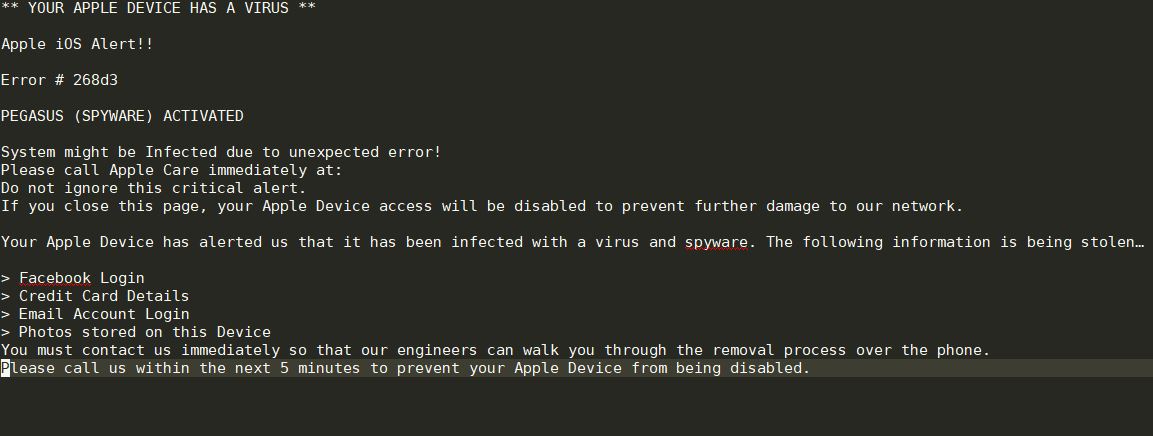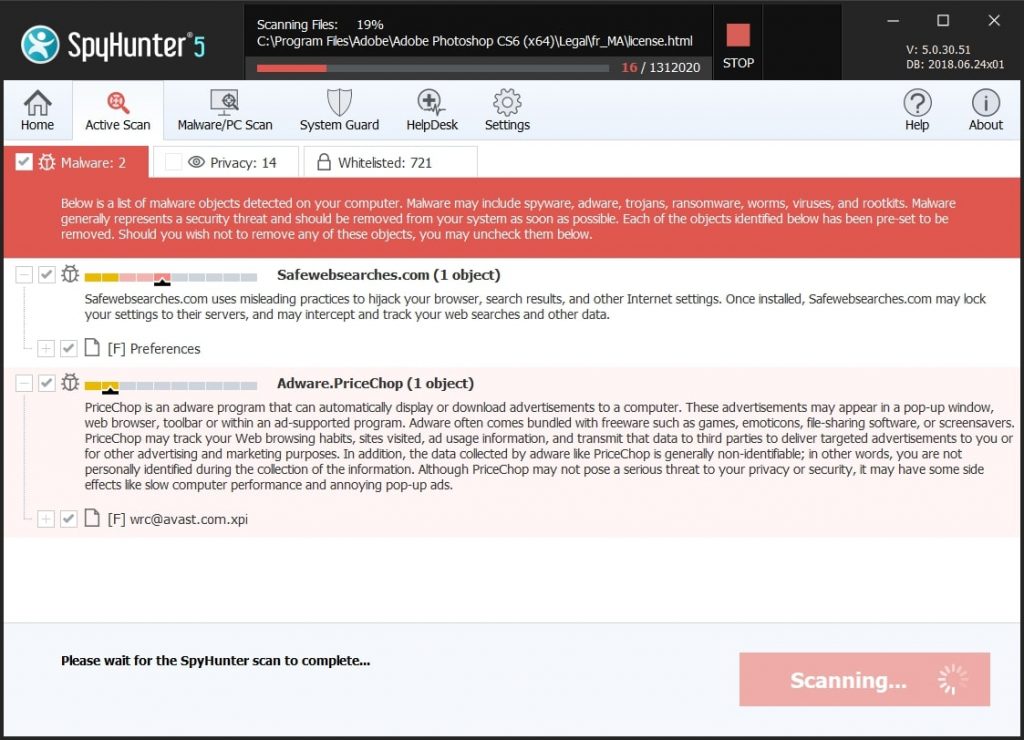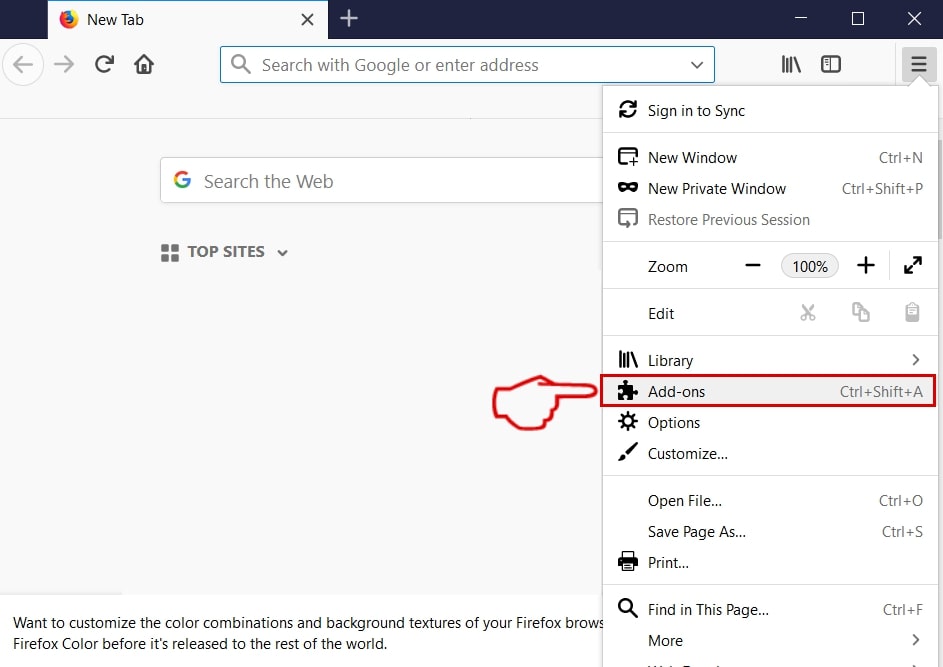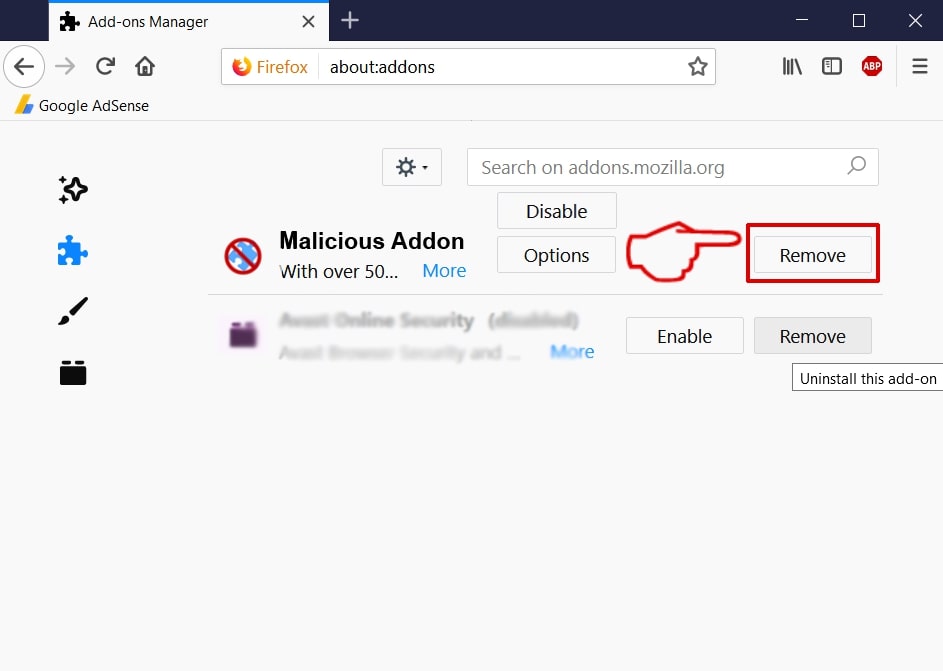YOUR APPLE DEVICE HAS A VIRUS (Apple Scam) is a common fake tech support scam that is being distributed in an active distribution campaigns. Various criminal collectives throughout the years have been known to use it. Our article gives victims information on removing active infections from their Mac OS X computers.


Threat Summary
| Name | YOUR APPLE DEVICE HAS A VIRUS |
| Type | Phishing scam, Fake Tech Support message |
| Short Description | An Apple scam that combines a virus deployment with a fake tech support criminal scheme. |
| Symptoms | The victim users will be shown a fake tech support Apple scam message. |
| Distribution Method | Bundled downloads, malicious scripts and other methods. |
| Detection Tool |
See If Your System Has Been Affected by malware
Download
Combo Cleaner
|
User Experience | Join Our Forum to Discuss YOUR APPLE DEVICE HAS A VIRUS. |
YOUR APPLE DEVICE HAS A VIRUS (Apple Scam) – How Did I Get It
Security reports indicate that there is an ongoing campaign delivering the YOUR APPLE DEVICE HAS A VIRUS (Apple Scam) phishing threat. This is a common scheme that is being used by several hacker collectives at once with slight modifications. The main method of delivery is the creation of fake web sites. They use stolen elements from well-known sites and services that the targets may use on a regular basis. Through various scripts the users can be made into victims — pop-ups, banners, redirects and in-body links.
The messages can also be distributed in email messages that are sent in bulk in a SPAM-like manner. They are designed so that they look like notifications sent by legitimate companies. When they are opened by the victims YOUR APPLE DEVICE HAS A VIRUS (Apple Scam) may be displayed directly. In other cases it can be linked by hyperlinks or other interactive elements.
The main goal of the threat is to persistently display fake warning messages. As such other techniques can also be employed. An example is the inclusion of the Apple Scam in the two most popular infected payloads:
- Documents — The hackers can produce macro-infected documents (text documents, spreadsheets, databases and presentations). When they are opened by the victims a warning message will ask them if they want to enable the built-in scripts. If the users agree then the infection will begin.
- Infected Software Setup Files — Through malicious application installers the criminal operators behind the Apple scam can distribute the threat. This is a method that is popular mainly with viruses. The hackers modify the legitimate installers of popular software with the virus code by choosing popular choices: creativity suites, productivity apps and system utilities.
Scams like this one can also be spread using browser hijackers. They are malicious web browser plugins that are made for the most popular applications: Mozilla Firefox, Google Chrome, Opera, Safari, Internet Explorer and Microsoft Edge. They are most often found on the associated extension repositories with fake user reviews and developer credentials. When they are installed by the victims the built-in commands will reconfigure the browsers to redirect the users to a hacker-controlled page. The next step is to deliver the virus infection to the hosts.
YOUR APPLE DEVICE HAS A VIRUS (Apple Scam) – More Information
Upon installation of the malware code the victims will receive a malicious pop-up in an application frame or browser window with the title “PEGASUS SPYWARE ACTIVATED”. Its contents reads the following:
** YOUR APPLE DEVICE HAS A VIRUS **
Apple iOS Alert!!
Error # 268d3
PEGASUS (SPYWARE) ACTIVATED
System might be Infected due to unexpected error!
Please call Apple Care immediately at:
Do not ignore this critical alert.
If you close this page, your Apple Device access will be disabled to prevent further damage to our network.Your Apple Device has alerted us that it has been infected with a virus and spyware. The following information is being stolen…
> Facebook Login
> Credit Card Details
> Email Account Login
> Photos stored on this Device
You must contact us immediately so that our engineers can walk you through the removal process over the phone. Please call us within the next 5 minutes to prevent your Apple Device from being disabled.
Depending on the version of the threat the text may be accompanied by a wallpaper change, music and other rich text media which can further coerce the victim to the scam.
The tech support support scam element blackmails the users into thinking that they need professional help to remove the threat. This is not the case as the virus code is created to extort money via this social engineering trick. Victims should only trust а legitimate cleaner utility.
In some cases the infections may cause other damage to the victim hosts which is why the victims will need to use it. This is not a spyware virus, but a fake message that can be used by the operators to carry out multiple malicious actions:
- Files Access — The criminals can retrieve files found on the infected machines.
- Trojan Module — The remote instance can set up an encrypted connection to a hacker-controlled server. It can be used to spy on the users in real-time and deploy viruses.
- Applications Monitoring — The scripts can monitor the currently running applications for the startup of security software and close them. Only a proper cleaner tool will be able to bypass this protection.
Steps to Prepare Before Removal:
Before starting to follow the steps below, be advised that you should first do the following preparations:
- Backup your files in case the worst happens.
- Make sure to have a device with these instructions on standy.
- Arm yourself with patience.
- 1. Scan for Mac Malware
- 2. Uninstall Risky Apps
- 3. Clean Your Browsers
Step 1: Scan for and remove YOUR APPLE DEVICE HAS A VIRUS files from your Mac
When you are facing problems on your Mac as a result of unwanted scripts and programs such as YOUR APPLE DEVICE HAS A VIRUS, the recommended way of eliminating the threat is by using an anti-malware program. SpyHunter for Mac offers advanced security features along with other modules that will improve your Mac’s security and protect it in the future.

Quick and Easy Mac Malware Video Removal Guide
Bonus Step: How to Make Your Mac Run Faster?
Mac machines maintain probably the fastest operating system out there. Still, Macs do become slow and sluggish sometimes. The video guide below examines all of the possible problems that may lead to your Mac being slower than usual as well as all of the steps that can help you to speed up your Mac.
Step 2: Uninstall YOUR APPLE DEVICE HAS A VIRUS and remove related files and objects
1. Hit the ⇧+⌘+U keys to open Utilities. Another way is to click on “Go” and then click “Utilities”, like the image below shows:

2. Find Activity Monitor and double-click it:

3. In the Activity Monitor look for any suspicious processes, belonging or related to YOUR APPLE DEVICE HAS A VIRUS:


4. Click on the "Go" button again, but this time select Applications. Another way is with the ⇧+⌘+A buttons.
5. In the Applications menu, look for any suspicious app or an app with a name, similar or identical to YOUR APPLE DEVICE HAS A VIRUS. If you find it, right-click on the app and select “Move to Trash”.

6. Select Accounts, after which click on the Login Items preference. Your Mac will then show you a list of items that start automatically when you log in. Look for any suspicious apps identical or similar to YOUR APPLE DEVICE HAS A VIRUS. Check the app you want to stop from running automatically and then select on the Minus (“-“) icon to hide it.
7. Remove any leftover files that might be related to this threat manually by following the sub-steps below:
- Go to Finder.
- In the search bar type the name of the app that you want to remove.
- Above the search bar change the two drop down menus to “System Files” and “Are Included” so that you can see all of the files associated with the application you want to remove. Bear in mind that some of the files may not be related to the app so be very careful which files you delete.
- If all of the files are related, hold the ⌘+A buttons to select them and then drive them to “Trash”.
In case you cannot remove YOUR APPLE DEVICE HAS A VIRUS via Step 1 above:
In case you cannot find the virus files and objects in your Applications or other places we have shown above, you can manually look for them in the Libraries of your Mac. But before doing this, please read the disclaimer below:
1. Click on "Go" and Then "Go to Folder" as shown underneath:

2. Type in "/Library/LauchAgents/" and click Ok:

3. Delete all of the virus files that have similar or the same name as YOUR APPLE DEVICE HAS A VIRUS. If you believe there is no such file, do not delete anything.

You can repeat the same procedure with the following other Library directories:
→ ~/Library/LaunchAgents
/Library/LaunchDaemons
Tip: ~ is there on purpose, because it leads to more LaunchAgents.
Step 3: Remove YOUR APPLE DEVICE HAS A VIRUS – related extensions from Safari / Chrome / Firefox









YOUR APPLE DEVICE HAS A VIRUS-FAQ
What is YOUR APPLE DEVICE HAS A VIRUS on your Mac?
The YOUR APPLE DEVICE HAS A VIRUS threat is probably a potentially unwanted app. There is also a chance it could be related to Mac malware. If so, such apps tend to slow your Mac down significantly and display advertisements. They could also use cookies and other trackers to obtain browsing information from the installed web browsers on your Mac.
Can Macs Get Viruses?
Yes. As much as any other device, Apple computers do get malware. Apple devices may not be a frequent target by malware authors, but rest assured that almost all of the Apple devices can become infected with a threat.
What Types of Mac Threats Are There?
According to most malware researchers and cyber-security experts, the types of threats that can currently infect your Mac can be rogue antivirus programs, adware or hijackers (PUPs), Trojan horses, ransomware and crypto-miner malware.
What To Do If I Have a Mac Virus, Like YOUR APPLE DEVICE HAS A VIRUS?
Do not panic! You can easily get rid of most Mac threats by firstly isolating them and then removing them. One recommended way to do that is by using a reputable malware removal software that can take care of the removal automatically for you.
There are many Mac anti-malware apps out there that you can choose from. SpyHunter for Mac is one of the reccomended Mac anti-malware apps, that can scan for free and detect any viruses. This saves time for manual removal that you would otherwise have to do.
How to Secure My Data from YOUR APPLE DEVICE HAS A VIRUS?
With few simple actions. First and foremost, it is imperative that you follow these steps:
Step 1: Find a safe computer and connect it to another network, not the one that your Mac was infected in.
Step 2: Change all of your passwords, starting from your e-mail passwords.
Step 3: Enable two-factor authentication for protection of your important accounts.
Step 4: Call your bank to change your credit card details (secret code, etc.) if you have saved your credit card for online shopping or have done online activiites with your card.
Step 5: Make sure to call your ISP (Internet provider or carrier) and ask them to change your IP address.
Step 6: Change your Wi-Fi password.
Step 7: (Optional): Make sure to scan all of the devices connected to your network for viruses and repeat these steps for them if they are affected.
Step 8: Install anti-malware software with real-time protection on every device you have.
Step 9: Try not to download software from sites you know nothing about and stay away from low-reputation websites in general.
If you follow these reccomendations, your network and Apple devices will become significantly more safe against any threats or information invasive software and be virus free and protected in the future too.
More tips you can find on our MacOS Virus section, where you can also ask any questions and comment about your Mac problems.
About the YOUR APPLE DEVICE HAS A VIRUS Research
The content we publish on SensorsTechForum.com, this YOUR APPLE DEVICE HAS A VIRUS how-to removal guide included, is the outcome of extensive research, hard work and our team’s devotion to help you remove the specific macOS issue.
How did we conduct the research on YOUR APPLE DEVICE HAS A VIRUS?
Please note that our research is based on an independent investigation. We are in contact with independent security researchers, thanks to which we receive daily updates on the latest malware definitions, including the various types of Mac threats, especially adware and potentially unwanted apps (PUAs).
Furthermore, the research behind the YOUR APPLE DEVICE HAS A VIRUS threat is backed with VirusTotal.
To better understand the threat posed by Mac malware, please refer to the following articles which provide knowledgeable details.













